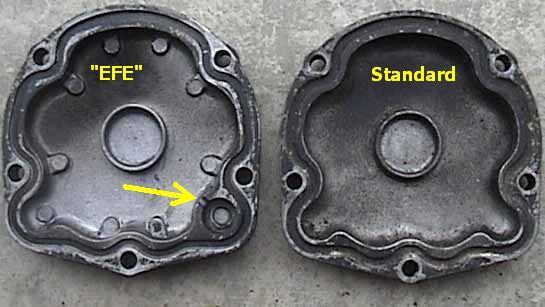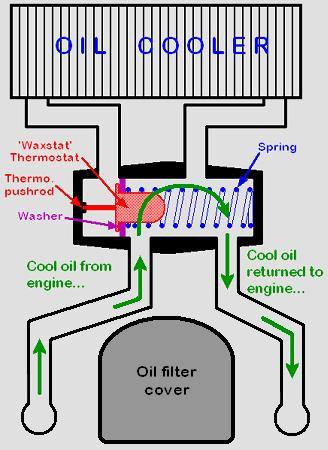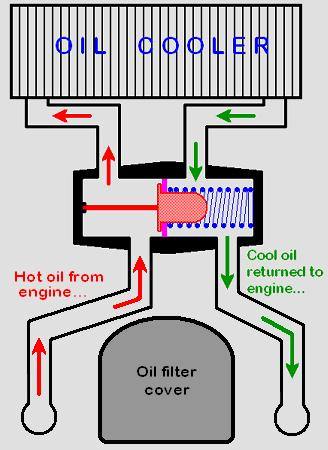
[Before you go too much further, you might like to read The Unfortunate But Necessary Disclaimer.]
I bought my '81 Kat1100 with a substantial oil cooler (an Earl's unit) already installed. However, by comparing the temperature of the hoses to and from the cooler after a long run, there didn't seem to be much temp. difference between the two, and so I wondered if the cooler was functioning properly.
So I put my question about this on the Forum at Katana Central — and I got a lot of helpful advice (see Thread 696) and so I was able to make some sense of the situation. At the same time, I did a fair bit of trawling across the Internet and came across other advice that I have now come to see as being of 'varied' quality.
Enough prattle. My conclusions are as follows:
Part One
In un-modified form, the situation with a GSX1100 engine before you attach an oil cooler, is shown in Figure 1. All of the oil from the oil pump enters the filter housing directly, and passes through the filter to the rest of the engine. And the blanking plugs just sit there, BEGGING you to install an oil cooler. They are very hard to ignore, aren't they.
Figure 1: 
As far as I can tell, there is a fair bit of misinformation floating around out there, that more or less states that if you install an oil cooler without blocking off the relevant oil way using (i) a purpose-made plug, or (ii) an 'EFE' oil-filter cover, then you will surely cook the cylinder head. There was even an old bike magazine article I came across in my travels, that declared that there were cooked GSX-1100 heads propping open garage doors all over England, because people had failed to redirect the oil when they installed an oil cooler!
I now think that all this is plain wrong. As one correspondent on the Katana Central forum pointed out, even if the relevant plug or filter cover is not installed there can be no loss in oil pressure because it is a closed system (see Figure 2).
Figure 2: 
In real terms, all that will happen if no plug or EFE filter cover is installed, is that the oil flow will be shared between the path to the oil filter, and the path to the oil cooler. But because the oil cooler feeds back into the filter recess anyway, there is no pressure-loss or reduction of oil volume flowing through the system overall.
This verdict is backed up by the fact that my bike had its oil cooler installed for years before I bought it, without the afore-mentioned plug or EFE filter cover, and there was no sign at all of over-heating cam journals and the many other dire consequences the prophets of doom have been crowing on about. None whatsoever.
So here is my first conclusion: if you don't block off the relevant oil way with a plug or an EFE filter cover, there will be no damage.
HOWEVER... however, in my travels I have come to understand that a plug or EFE filter cover is still a mighty good idea! Why do I think this? Read on...
Part Two
What we need to do, I think, is understand just what the 'EFE' filter cover is designed to achieve. As the pictures below make clear (courtesy of 'Katman'), the EFE filter cover — which was made by Suzuki for their GSX-engined machines which came with an oil cooler fitted as standard — has an extra 'baffle' cast on the inside, right where the oil is pumped into the filter housing from the engine.


Now it is important to realise that this 'baffle' is not there to block the oil flow into the filter housing — it is only designed to restrict it. Some of the oil being pumped from the engine can still make its way directly into the filter housing, as there is a restricted gap by virtue of the 'baffle', but — importantly — more oil is now redirected through the oil cooler. (See Figure 3.)
Figure 3: 
Which is exactly what the people at Suzuki wanted to achieve, I guess. For there is no point having an oil cooler if you're only going to get minimal oil-flow through it.
But at the same time, it appears that the folk at Suzuki didn't want to have the oil from engine pumped EXCLUSIVELY through the oil cooler — hence the baffle on the inside of the filter cover.
Now it's a bit hard to imagine why things have been designed this way. One reason might be, I suspect, for safety's sake. I mean, if all your oil is being pumped through the oil cooler and it blocks up with gunk or sludge, then you could end up with a seized engine as all the oil paths to the engine have been blocked.
But then again, we must keep in mind that there is a by-pass valve incorporated in the oil-system's design, so that (for example) if the oil-filter is hopelessly blocked, then the valve is opened so that the engine doesn't starve of oil. And in the event of a blocked oil cooler, the same valve would perform the same function. [And thanks to Warwick for pointing out the bleedin' obvious to me on this one!]
OK then, here's another explanation: perhaps it was a compromise situation so that bikes sold to colder climates (eg. northern Europe and North America) wouldn't get too much cooling happening. But as discussed below (under 'The Thermostat Matters'), the best way to guard against this is to install an oil cooler thermostat on the lines coming to and from the cooler.
Anyway, who knows. Until some knowledgeable boffin comes along to enlighten us, all we can do is speculate as to why the EFE cover aims to redirect most, but not all, of the oil through the cooler. The main question is, what does all this mean for fitting an oil cooler to our GSX-engined machines?
Part Three
What it means is, unless you can think of a good reason to route ALL of the oil through the cooler, probably the safest bet is to install an EFE filter cover. It's the way Suzuki designed it, and it's probably the better way to go for that reason (although not everything designed by Suzuki is good!).
But if you fit a plug into the relevant oil-way instead of getting an EFE filter cover (as per Figure 4 below), then your oil cooler will work, and not just sit there looking pretty. And as long as your oil cooler maintains good flow and doesn't get gunked up, this setup should be fine. With modern oils and regular oil-changes, sludge build-up simply shouldn't be an issue.
Figure 4: 
Now if you can't get your mits on an EFE filter cover, but you have a plug, then one thing you could do to emulate the partial restriction of the filter cover (if you so wish) is simply drill a hole up the centre of the plug.
Now the semi-circular slot through the baffle of the EFE cover is about 3.5 mm across (thanks to Mel for getting this measurement to me), and it works out that to achieve the same cross-sectional area for a circular hole, you would need a 2.47mm hole drilled up the centre of your plug. (Of course, no one sells 2.47mm drill bits, but 2.5mm bits are as common as mouse poop.)
For those of you who would like to know, the formula I came up with and used in my calculation is...

... where d2 is the diameter of a semicircle, and d1 is the diameter of the hole you'll need to drill to achieve the same cross-sectional area (and thus — in this case — corresponding oil volume delivery). So, 3.5mm divided by the squareroot of 2 delivers 2.47mm. But don't take my word for it; I had to dust off some basic school-boy maths for that! By all means, dust off your own and see how you go.
The Thermostat Matters
Now there are two circumstances in which you probably don't want your engine oil being cooled:
- while the engine is warming up soon after you've thumbed the starter-button, and
- when the weather is super-cold such as what our northern-hemisphere mates get for several months every year.
So what can we do about it? The answer, my friends, is not blowing in the wind. It is found in the form of this useful device: the oil cooler thermostat.

I got this one off eBay. There are some out there that look a bit different, but essentially they all operate the same way, ie. there's a total of 4 oil entry/ exit points, and a 'waxstat' type of thermostat buried in its heart. I made the brass brackets to mount the thermostat to the frame. On the GSX1100 Katanas, there is a cross-member between the frame downtubes which — usefully — has a bracket with two 6mm threaded holes. Dunno what the bracket was for originally, but it makes for a very handy thermostat mounting location.
So how does one of these interesting critters work, and how would you hook one up? Well, take a look at the diagrams below. First off, when the oil is cold (typically less than 85°C), the thermostat's valve is closed and the cooler is bypassed:
Figure 5: 
But when she's getting hot under the collar, the thermostat opens to divert the oil through the cooler, and all is bliss:
Figure 6: 
The current setup on my machine is with a thermostat fitted, and an oil diversion plug (with no hole bored up its centre) inserted into the oil galley as per Figure 4 above. And I think it all works a treat. Here are a few pics (and please excuse the quietly rusting header pipes — another job to do)...
Now if you're the cautious type, you may well be wondering: "But what if this speccy piece of thermostat hardware goes belly-up? And your lovely tuned and fettled engine starves of oil and cooks itself solid? What then?" Hmm, yes I did wonder about this myself... but think it through with me...
If the thermostat gets stuck, it will be either stuck open or shut. If stuck open all the time, then the oil will be channelled through the cooler all the time — which isn't the desired outcome, I know, but it's not going to be terminal for the engine. And if it's stuck shut, similar thing: the oil will simply bypass the cooler all the time. Not desirable, I know, but not terminal either. Either way I cannot see how your engine would starve of oil.
Thermostats for bike applications can be found at
- Mocal oil coolers and components. For our motorcycles, their 'OT/1' thermostat looks like the one to go for.
- britcycle.com. Very similar (if not identical) to the Mocal product.
What If I Have A 2-valve GS?
The answer is, you have to hook up a cooler via the oil-pressure switch cover (which lies on top of the crankcase behind the cylinder block). You can't use the plugged holes either side of the oil filter cover for the simple reason that there aren't any on the older 2-valve engines.
So what you need is an adapter plate like this:

If you'd like one of these oil cooler adapters, and take it from there. He made the one in the photo above for my GS1000S, and it's a very neat bit of workmanship.
Wrapping Things Up
This brings you to the end of my thinking on GSX1100 oil cooler matters. Of course I am more than happy to be corrected on any of the information and ideas I have presented here, as like you I just want an engine that works, and works well. Because the GSX1100 engine is undoubtedly the most excellent engine ever made for anything (although that 24 litre, 12 cylinder lump in the Napier-Railton must come close).
The Unfortunate But Necessary Disclaimer:
All of the information here is for you to weigh up and use AT YOUR OWN RISK. While I have taken great care to ensure that the information on this page is accurate, YOU are the one who must judge whether the information in this article is correct and applicable to your machine and circumstances.
Furthermore, I am not a mechanic or engineer. I have no related qualifications and I am not endorsing, recommending or advising in any way. I strongly recommend that anything on this webpage be discussed with your local mechanic before any action is taken to implement the content of this webpage. I make no claims to being a 'guru' — there are enough of these boorish types out here in cyberspace as it is. All I have tried to do is think through things logically and clearly. You be the judge. So there.
Not only that, but YOU ALONE are responsible for any injuries you may sustain in acting on the information described on this webpage. You will note that all manner and types of mishap are not mentioned. So if you do them, they are not my fault, but YOURS. In short, don't blame me if something goes pear-shaped.
Oh for a world without wretched disclaimers.
[Back to top]
Lubrication System Schematics
Ever wondered how the oil is circulated in your GS(X)1100 'TSCC' engine?
Well, Arnout has done a great job here of tarting-up the standard B&W Suzuki GSX1100 oil-flow diagram, so we can actually figure out where the oil goes, without going cross-eyed and copping a migraine!
And here is a generalised lubrication system flow chart for the GS(X)1100 engine.
So what happens when a hose fitting breaks?
Well, if you're doing about 120kph on the open road as I was, the first thing you notice is a huge blue cloud of smoke behind you as the oil is spraying onto the toasty hot header pipes, see. Then you hit the kill switch, pull over, get off, and ponder the hot black oil dripping off your engine into the red Australian dirt. And rue the day you decided to skimp on buying proper bayonet fittings to connect your oil cooler thermostat, and thought you could solder some up yourself, ahem. Then thankfully it's only a short push of the the 240kg Katana back up the highway to the BP service station at Lake Clifton, where you take the following photo with your cruddy mobile phone camera for posterity:

Final move is to lean upon a long-suffering mate with a trailer to come and pick you up.
* * * * *



